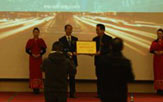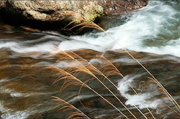Ningde Global GeoPark
( chinadaily.com.cn )
Updated: 2011-04-01
Floral Resources
The forest coverage rate in the three scenic areas of the park is 72 percent to 90 percent. The native vegetation is evergreen broad-leaf forests.
It belongs to the wet forest region in East China, one of the three largest vegetation regions in China. The major vegetation types in the park include evergreen coniferous forests, evergreen broad-leaved forests, mixed evergreen coniferous and broad-leaf forest, evergreen shrubbery, bamboo groves and grass slopes. The park contains most of the vegetation common to a Chinese middle subtropical zone.
The vegetation in Baishuiyang Scenic Area can be classified into 10 subtypes: temperate coniferous forest, warm coniferous forest, broad-leaf deciduous forest, evergreen broad-leaf forest, bamboo grove, broad-leaf deciduous shrubbery, typical evergreen broad-leaf shrubbery and shrub grassland.
In the park, the named vascular plants have 162 families, 508 genera and 855 species, and rare or endangered plants account for 11 families, 18 genera and 26 species. Among them, there are 18 species of plants under state Class I or Class II protection, and 13 plants under provincial key protection.
The park is home to water pines, rare plants dating to the Ice Age and often called “living fossils of plants”. The park is an important place for the preservation of Tertiary and Quaternary Era plants in South China. The vegetation in Baiyun Mountain Scenic Area can be classified into six typical types: evergreen coniferous forest, shrubbery, evergreen broad-leaf forest, mixed forest, bamboo grove and grass slope.
In the area, the vascular plants account for 1,015 species. Among them, ferns account for 28 families, 41 genera and 65 species; gymnosperms have nine families, 16 genera and 23 species; and angiosperms have 136 families, 531 genera and 927 species. In the area, there are three species of plants under national Class I protection, 15 species under Class II protection and 12 families, 21 genera and 24 species of rare and endangered plants.
In Shouyang, Mayang, Lingxia and surrounding areas, plants under state protection include laxus malrel and cryptomerial fortunei. In Tianchi in front of Liafeng Temple in Baiyun Mountain, you can find nymphaea and other rare plants. The vegetation in Taimu Mountain Scenic Area can be classified into four types: broad-leaf forest, coniferous forest, bamboo forest and shrubbery. In the area, the vascular plants represent 491 species.
Among them, gymnosperms have nine families, 18 genera and 29 species. Angiosperms have 65 families, 194 genera and 462 species. There are five rare tree species under State protection. Water pine, gingko and fukienia hodginsii have Class II protection, and cycas taiwaniana and magnolia biloba have Class III protection.
There are a great variety of bamboos, including dendrocalamus affinis, dendrocalamus membranaceus munro, bambusa oldhamii munro, arundo donax linn, and chimonobambusa and black bamboo. The area also boasts a wide variety of colorful azaleas.
Near Dutou Village in the lower reaches of Yangjia Creek in the west section of the scenic area, a liquidambar formosana forest is home to 11,000 trees. It is the largest liquidambar formosana forest south of the Yangtze River. Behind Dutou Village, there are 17 ancient banyans that make up the northernmost ancient banyan forest in the world. The oldest ones are nearly 900 years old, and the younger trees can be more than 140 years old.
Animal Resources
The park’s animals mostly are species common to the Central China Region of Oriental Realm, and a small portion of them are species common to the South China Region.
Some are species common to the Palaearctic Realm. In the area, there are more than 2,000 species of wild animals, including more than 700 species of vertebrates. Among the vertebrates are more than 70 species of mammals, 324 species of birds, more than 100 species of reptiles, more than 30 species of amphibians and more than 600 species of fish. There are also more than 1,300 species of invertebrates.
The park is home to many rare and endangered animals. Animals under Class I protection include the clouded leopard, boa and Chinese sturgeon. Class II animals include the macaque, zibet, goat, pangolin, mandarin duck, kestrel, glede, hynobidae, rana tigrina, yanyan deer, silver pheasant, kingfisher, red-billed leiothrix, syrmaticus reevesii and elaphodus cephalophus.
Bird species at the park include the tree sparrow, collared crow, magpie, ring-necked pheasant, bamboo partridge, jay, red-headed crow, throated tit, red-billed blue magpie, blackbird, sparrow, falcated teal, mallard, enicurus immaculatus and sea gull. The park also is home to porcupines, wild boar, wild monkey, and badgers. Fish include yellow croakers, hairtail, grouper, weever, prawn, swimming crabs, blue crabs and cuttlefish.






